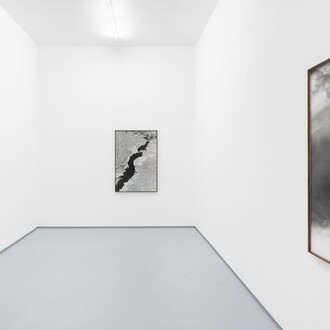In Turn, turn, turn, Maria Condado draws from the song of the same name by Pete Seeger (1959), popularized by The Byrds in 1965, to evoke the idea of cyclical movement — that everything has its time and that “everything flows,” as expressed in the music. Amplified in the 1960s, in the context of the Vietnam War, the song had a significant impact on social protest and pacifist movements, becoming a symbol of collective anti-war mobilization that influenced public opinion and contributed to the withdrawal of American troops.
With lyrics taken from the Book of Ecclesiastes 3:1–8, human existence is presented as a dialectical succession of opposites — to be born and to die, to plant and to harvest, to destroy and to rebuild — which not only describe contrasts but also convey a sense of urgency. Although the song can be interpreted as a poetic meditation on the transience of life, the context and the force it gained during a time of instability reveal its direct call for peaceful action and social transformation. A clear example is Pete Seeger’s addition of the line “I swear it’s not too late,” absent from the biblical text, which emerges as a plea for the urgency of change.
By invoking a historical period marked by social conflict and political engagement, Maria Condado reclaims painting as a functional and operative tool — one that does not limit itself to the final artistic object. Her approach involves broad brushstrokes and an open composition, where movement is central. More than the result of a conceptual plan toward a finished work, painting is understood as an intensification of concrete experience and of the very activity of the studio. The painting is dense, poured forth — not just through the incorporation of visual elements but through the boldness of the mark, the color, and the composition, engaging with diverse visual languages.
Just like the set of paintings arranged in a formal and cadenced rhythm in the main gallery, the adjoining — darkened — room presents a slide projection that revisits a historical practice of photographing studio life, first made visible by Gustave Courbet (L’atelier du peintre, 1855). This work is conceived as an extension of the studio process, not seeking to document — but perhaps to translate — the everyday experience of the workspace. Among the paintings, moments, images, and visual metaphors are captured that may arise as parallel commentaries on the issues of painting itself. The studio here is imagined as a laboratory: a place of experimentation and thought.
The choice to photograph on 35 mm slides and to present them via an 80-image carousel projector (as an analog and anachronistic scroll, perhaps) induces a deceleration, both in the production and in the viewing of the images. The projector’s continuous loop becomes, in itself, a circular gesture: turn, turn, turn — evoking the cycles that unfold during the months of exhibition preparation while, simultaneously, life flows on, both within the artist’s interior world and in the chaotic world around her.
By making the studio visible, Maria Condado displaces the private space into the exhibition space, presenting the studio as a place of life and experimentation, where thought and practice are intertwined. Thus, the act of making — with all its circumstances and issues — is understood as an integral part of the artwork, showing how, for the artist, the public and private realms merge, just as the artist cannot detach from concrete life. This gesture reaffirms Maria Condado’s commitment to social and political reality, and to a situated practice that asserts the present moment and is capable of intervening critically in it.
By evoking a historical period of social conflict and political engagement and referencing the studio environment, Maria Condado calls for the urgency of action, instigating the responsibility of art as an active instrument of interpretation, intervention, and transformation of its time.
We can think of these works as being driven by the ambition to make painting an active — rather than detached — element, focusing on the experiential and the procedural, understanding art as a “way of intensifying our presence in the world.”














